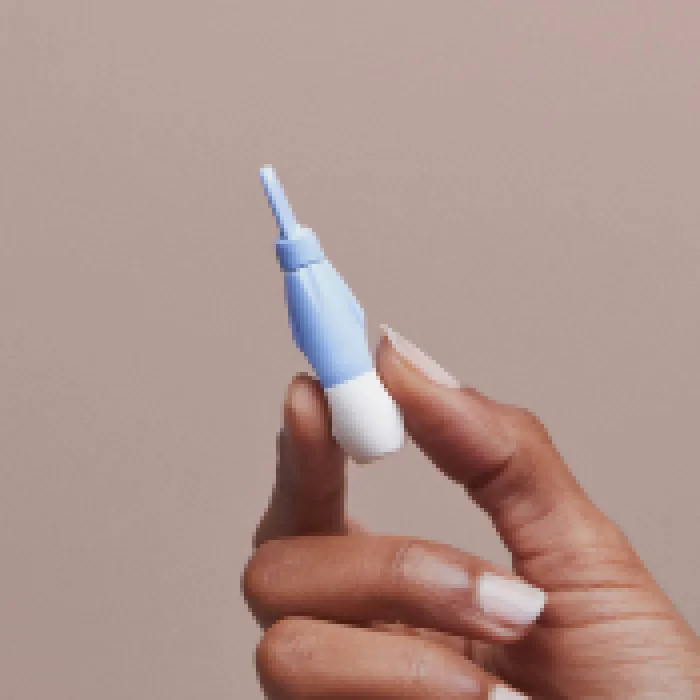Here's what we'll cover
Here's what we'll cover
Healthcare professionals regularly tell women to check for lumps in their breasts and to complete breast cancer screenings at the recommended time. But for some women, the first sign of breast cancer may not be a palpable lump but something that looks like a rash on the breast or nipple instead. This is called Paget’s disease of the breast, and it’s a pretty rare presentation of breast cancer.
It’s easy to overlook or misdiagnose because it can look similar to many common skin rashes that a woman may experience in her life. Many with Paget’s disease of the breast already have cancer somewhere else in the breast. In this case, the skin changes are often the first indication that breast cancer is present (Karakas, 2011).
Here’s what you need to know about Paget’s disease of the breast.
What is Paget’s disease of the breast?
Also called Paget’s disease of the nipple or mammary Paget disease, only about 4% of all women with breast cancer experience this rare type (Karakas, 2011).
Medical experts characterize Paget’s disease of the breast by cancerous cells in the nipple and the skin around the nipple (Karakas, 2011). The breast disease’s name comes from its founder Sir James Paget, who identified the first patients in 1874. It can get confusing because Paget has multiple diseases named after him, including a bone disease and one that affects both male and female genitalia. But Paget’s disease of the breast is always indicated as such and specifically impacts the breast (Yasir, 2021).
Paget’s disease of the breast is most common in post-menopausal women. Men can also be diagnosed with this cancer. However, it is extremely rare (Karakas, 2011).
The majority of women with Paget’s disease of the breast have breast cancer somewhere else in the breast like (Chen, 2006):
Ductal carcinoma in situ (DCIS): abnormal cells found in the breast’s milk duct (Vaidya, 2015)
Invasive ductal cancer (IDC): cancer that starts in the milk duct that spreads in the breasts and to other lymph nodes and tissues (Scholl, 2020)
It is also possible that Paget’s disease of the breast is present without underlying breast cancer, but that’s rare (Chen, 2006).
What are the symptoms?
The main symptoms of Paget’s disease of the breast include (Dalberg, 2008; Karakas, 2011; Yasir, 2021):
Inflamed, itchy, and scaly pink or red lesions of the nipple or areola
Bleeding from the lesions
Inverted or retracted nipple
Nipple discharge
Pain or burning sensation of the nipple or breast
These symptoms typically only impact one of the breasts; they rarely impact both breasts or nipples (Karakas, 2011). Some of these symptoms make it seem like it’s just a rash on the breast, like if you wore a sweaty sports bra for too long or tried a new detergent. However, if you experience any of these symptoms, it’s important to see a doctor for proper diagnosis and treatment.
A lump somewhere else in the breast may or may not be present. If you feel a lump in addition to noticing a rash, take it as a sign to seek medical attention immediately (Vaidya, 2015).
What causes Paget’s disease of the breast?
Medical experts don’t know for sure what causes Paget’s disease of the breast. Some think that there's a connection to other breast cancers because up to 88% of women also have another form of breast cancer. One theory is that these cells from a tumor somewhere else in the breast migrate through the milk ducts to reach the skin (Yasir, 2021).
Another less likely theory is that skin cells in the nipple transform or become cancerous without an underlying breast cancer somewhere else in the breast (Yasir, 2021).
What are the risk factors?
Risk factors for developing Paget’s disease of the breast overlap with risk factors for other breast cancers (Karakas, 2011).
Being a woman and being 50 years or older are two risk factors for breast cancer. Other risks of breast cancer include (Yasir, 2021):
Family history of breast or ovarian cancer
Radiation exposure
Genetic predisposition
High alcohol consumption
How is Paget’s disease of the breast diagnosed?
A healthcare provider can diagnose Paget’s disease of the breast from a clinical exam and a biopsy of a lesion. During the biopsy, they take a portion of the skin and analyze it under a microscope to confirm whether cancer cells are present (Karakas, 2011; Yasir, 2021).
After diagnosis, your healthcare provider may want to do more testing to see whether other breast cancers are present. Common diagnostic tests include mammography, ultrasound, and magnetic resonance imaging (MRI) (Karakas, 2011).
Mammography
Mammography—usually referred to as a mammogram—is one of the most widely used breast cancer screening tools today. It evaluates breast tissue and is essentially an x-ray of the breast. Around half of women with Paget’s disease of the breast have abnormal findings from this test, whether that’s a mass or thickening of the areola. But a negative test (where everything looks normal) doesn’t rule out cancer somewhere else in the breast. Your healthcare provider may need other tests for confirmation (Yasir, 2021).
Ultrasound
Ultrasound uses sound waves to paint a picture of what’s going on internally. It may be helpful as part of the initial evaluation, especially if a mammogram is negative. But it’s not very specific, so this test alone doesn’t determine if a type of cancer is present (Karakas, 2011).
MRI
MRI is another imaging test that healthcare providers recommend to evaluate the true extent of disease. It uses a magnetic field to get an even more detailed view than ultrasound of tissues and organs. This test requires you to lie still in a tube-like machine at a hospital or a doctor's office (Berger, 2002).
All three of these diagnostic tests work together to identify underlying breast cancer. This is a highly personalized process, and your healthcare provider will recommend tests that would be most beneficial for your specific situation.
What are the treatment options?
Without any treatment, the skin lesions spread, and invasive breast cancer can develop and grow out of control (Karakas, 2011). The two common treatment options are mastectomy or breast-conserving surgery. Mastectomy (surgery to remove the whole breast) used to be the recommended route for treating Paget’s disease of the breast whether a mass was present or not (Caliskan, 2008).
But research now shows that breast-conserving strategies (like removing only the nipple) can be just as good as mastectomies at keeping women free of cancer (Caliskan, 2008; Dalberg, 2008; Kawase, 2005). Radiation therapy may also be a part of the treatment plan for breast-conserving surgeries (Caliskan, 2008).
Treatment for this uncommon type of breast cancer depends on the individual. Your healthcare provider will walk you through the different options and will work with you to develop a treatment plan that suits your needs.
Can Paget’s disease of the breast be prevented?
You cannot prevent Paget’s disease of the breast. But proper screening for breast cancer can help catch breast cancer early and improve the outcome of the disease (Monticciolo, 2020).
The American Cancer Society recommends women start screening for breast cancer at age 45 and get annual mammogram screenings until 54 years of age (Jin, 2015). However, it’s important to talk with your healthcare provider about your medical history and family medical history because they may recommend a different screening approach.
What to keep in mind about this uncommon breast cancer
Since some symptoms of Paget’s disease of the breast resemble those of less harmful skin conditions (like a rash, eczema, or psoriasis), it may not seem like a big deal when you notice it.
But red, scaly, painful lesions that only arise on one nipple or areola are indicative of Paget’s disease of the breast, and you should contact a doctor immediately. Diagnosis, treatment plans, and outlook of the disease may look different for each person and depend on the presence and extent of an underlying breast cancer.
DISCLAIMER
If you have any medical questions or concerns, please talk to your healthcare provider. The articles on Health Guide are underpinned by peer-reviewed research and information drawn from medical societies and governmental agencies. However, they are not a substitute for professional medical advice, diagnosis, or treatment.
Berger, A. (2002). Magnetic resonance imaging. BMJ (Clinical research ed.), 324 (7328), 35. doi: 10.1136/bmj.324.7328.35. Retrieved from https://pubmed.ncbi.nlm.nih.gov/11777806/
Caliskan, M., Gatti, G., Sosnovskikh, I., Rotmensz, N., Botteri, E., Musmeci, S., et al. (2008). Paget's disease of the breast: the experience of the European Institute of Oncology and review of the literature. Breast Cancer Research and Treatment, 112 (3), 513–521. doi: 10.1007/s10549-007-9880-5. Retrieved from https://pubmed.ncbi.nlm.nih.gov/18240020/
Chen, C. Y., Sun, L. M., & Anderson, B. O. (2006). Paget disease of the breast: changing patterns of incidence, clinical presentation, and treatment in the U.S. Cancer, 107 (7), 1448–1458. Doi: 10.1002/cncr.22137. Retrieved from https://acsjournals.onlinelibrary.wiley.com/doi/10.1002/cncr.22137
Dalberg, K., Hellborg, H., & Wärnberg, F. (2008). Paget's disease of the nipple in a population based cohort. Breast Cancer Research and Treatment, 111 (2), 313–319. doi: 10.1007/s10549-007-9783-5. Retrieved from https://pubmed.ncbi.nlm.nih.gov/17952590/
Jin, J. (2015). Breast cancer screening guidelines in the United States. JAMA, 314 (15), 1658. doi: 10.1001/jama.2015.11766. Retrieved from https://jamanetwork.com/journals/jama/fullarticle/2463258
Kawase, K., Dimaio, D. J., Tucker, S. L., Buchholz, T. A., Ross, M. I., Feig, B. W., et al. (2005). Paget's disease of the breast: there is a role for breast-conserving therapy. Annals of Surgical Oncology, 12 (5), 391–397. doi: 10.1245/ASO.2005.05.026. Retrieved from https://pubmed.ncbi.nlm.nih.gov/15915373/
Karakas, C. (2011). Paget's disease of the breast. Journal of Carcinogenesis, 10,
doi: 10.4103/1477-3163.90676. Retrieved from https://pubmed.ncbi.nlm.nih.gov/22279416/
Monticciolo, D. L. (2020). Current Guidelines and Gaps in Breast Cancer Screening. Journal of the American College of Radiology : JACR, 1 7(10), 1269–1275. doi: 10.1016/j.jacr.2020.05.002. Retrieved from https://pubmed.ncbi.nlm.nih.gov/32473894/
Reeves, R. A., & Kaufman, T. (2021). Mammography. [Updated Jul 31, 2021]. In: StatPearls [Internet]. Retrieved from https://pubmed.ncbi.nlm.nih.gov/32644736/
Scholl, A. R., & Flanagan, M. B. (2020). Educational Case: Invasive Ductal Carcinoma of the Breast. Academic Pathology, 7, 2374289519897390. doi: 10.1177/2374289519897390. Retrieved from https://pubmed.ncbi.nlm.nih.gov/32010760/
Vaidya, Y., Vaidya, P., & Vaidya, T. (2015). Ductal Carcinoma In Situ of the Breast. The Indian Journal of Surgery, 77 (2), 141–146. doi: 10.1007/s12262-013-0987-0. Retrieved from https://pubmed.ncbi.nlm.nih.gov/26139969/
Yasir, M., Khan, M., & Lotfollahzadeh, S. (2021). Mammary Paget Disease. [Updated Jun 2, 2021]. In: StatPearls [Internet]. Retrieved from https://pubmed.ncbi.nlm.nih.gov/33085375/










